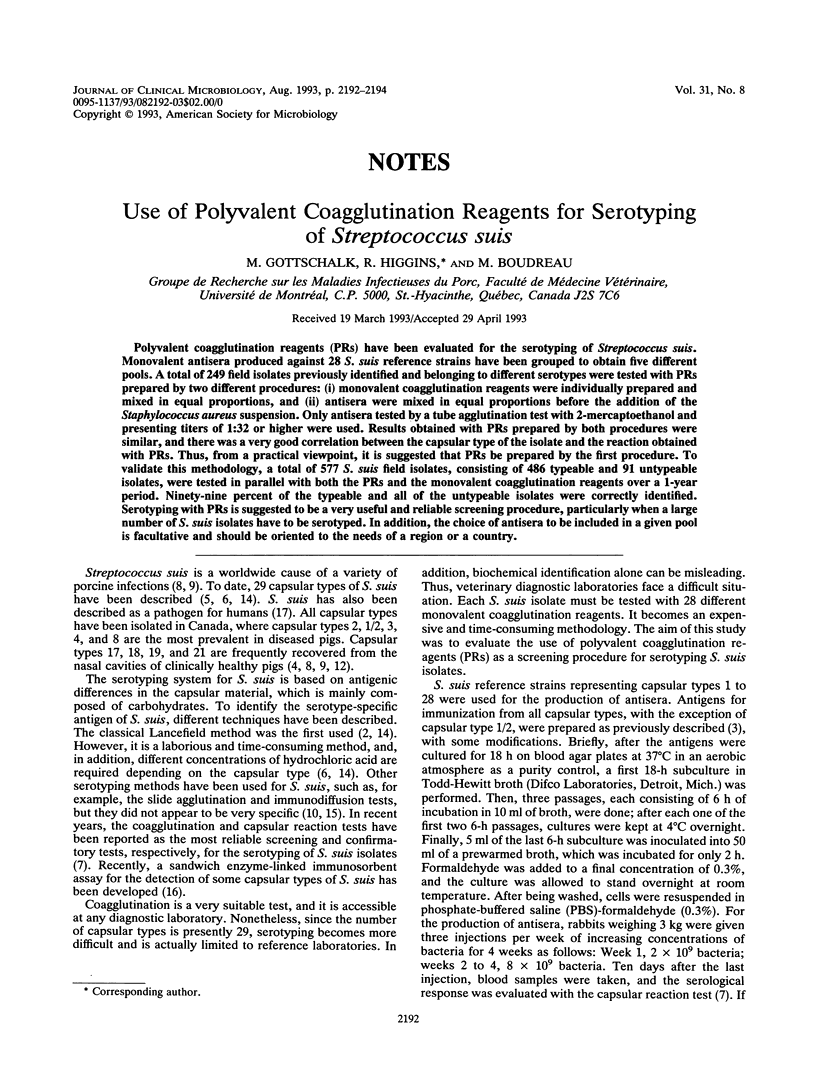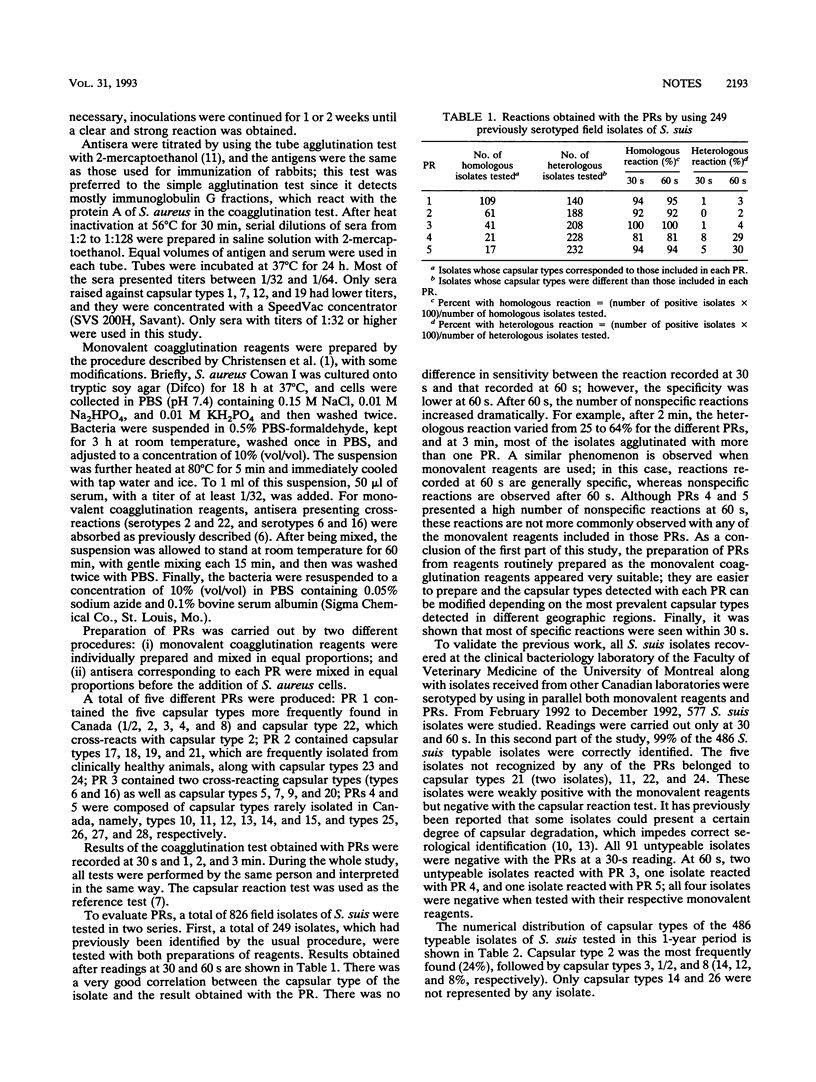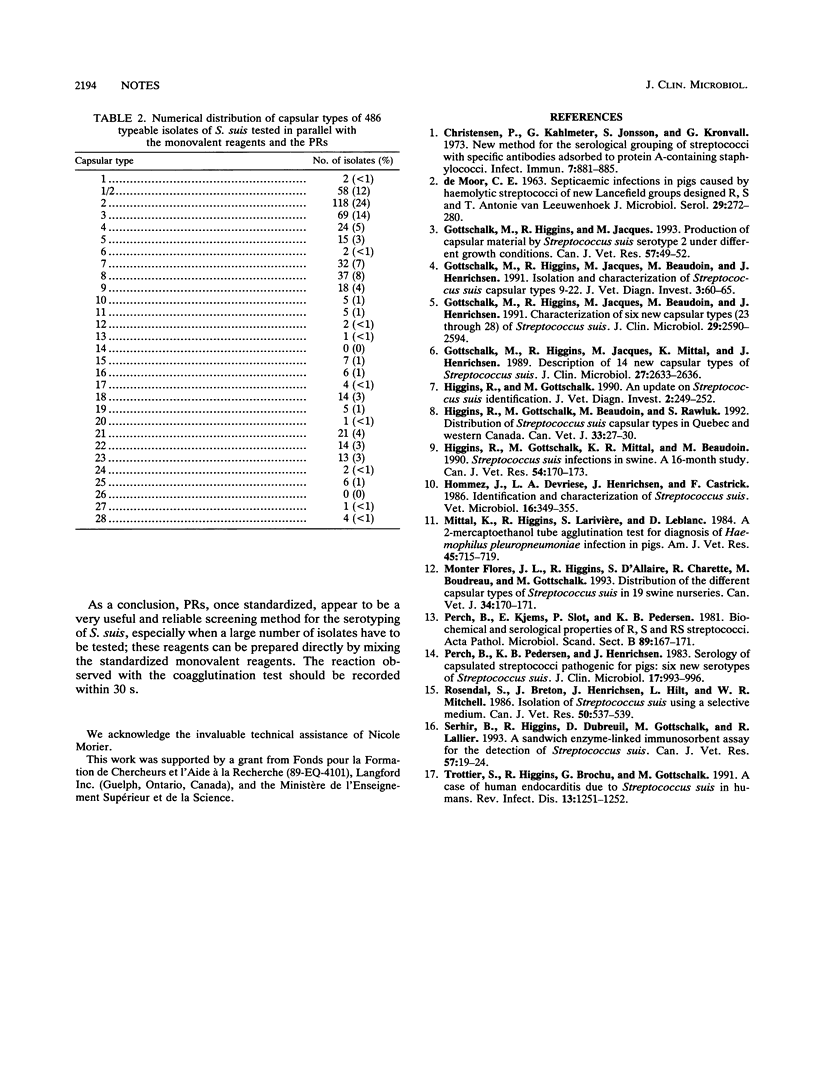Abstract
Polyvalent coagglutination reagents (PRs) have been evaluated for the serotyping of Streptococcus suis. Monovalent antisera produced against 28 S. suis reference strains have been grouped to obtain five different pools. A total of 249 field isolates previously identified and belonging to different serotypes were tested with PRs prepared by two different procedures: (i) monovalent coagglutination reagents were individually prepared and mixed in equal proportions, and (ii) antisera were mixed in equal proportions before the addition of the Staphylococcus aureus suspension. Only antisera tested by a tube agglutination test with 2-mercaptoethanol and presenting titers of 1:32 or higher were used. Results obtained with PRs prepared by both procedures were similar, and there was a very good correlation between the capsular type of the isolate and the reaction obtained with PRs. Thus, from a practical viewpoint, it is suggested that PRs be prepared by the first procedure. To isolates, were tested in parallel with both the PRs and the monovalent coagglutination reagents over a 1-year period. Ninety-nine percent of the typeable and all of the untypeable isolates were correctly identified. Serotyping with PRs is suggested to be a very useful and reliable screening procedure, particularly when a large number of S. suis isolates have to be serotyped. In addition, the choice of antisera to be included in a given pool is facultative and should be oriented to the needs of a region or a country.
Full text
PDF


Selected References
These references are in PubMed. This may not be the complete list of references from this article.
- Christensen P., Kahlmeter G., Jonsson S., Kronvall G. New method for the serological grouping of Streptococci with specific antibodies adsorbed to protein A-containing staphylococci. Infect Immun. 1973 Jun;7(6):881–885. doi: 10.1128/iai.7.6.881-885.1973. [DOI] [PMC free article] [PubMed] [Google Scholar]
- DEMOOR C. E. SEPTICAEMIC INFECTIONS IN PIGS, CAUSED BY HAEMOLYTIC STREPTOCOCCI OF NEW LANCEFIELD GROUPS DESIGNATED R, S, AND T. Antonie Van Leeuwenhoek. 1963;29:272–280. doi: 10.1007/BF02046069. [DOI] [PubMed] [Google Scholar]
- Flores J. L., Higgins R., D'Allaire S., Charette R., Boudreau M., Gottschalk M. Distribution of the different capsular types of Streptococcus suis in nineteen swine nurseries. Can Vet J. 1993 Mar;34(3):170–171. [PMC free article] [PubMed] [Google Scholar]
- Gottschalk M., Higgins R., Jacques M., Beaudoin M., Henrichsen J. Characterization of six new capsular types (23 through 28) of Streptococcus suis. J Clin Microbiol. 1991 Nov;29(11):2590–2594. doi: 10.1128/jcm.29.11.2590-2594.1991. [DOI] [PMC free article] [PubMed] [Google Scholar]
- Gottschalk M., Higgins R., Jacques M., Beaudoin M., Henrichsen J. Isolation and characterization of Streptococcus suis capsular types 9-22. J Vet Diagn Invest. 1991 Jan;3(1):60–65. doi: 10.1177/104063879100300113. [DOI] [PubMed] [Google Scholar]
- Gottschalk M., Higgins R., Jacques M., Mittal K. R., Henrichsen J. Description of 14 new capsular types of Streptococcus suis. J Clin Microbiol. 1989 Dec;27(12):2633–2636. doi: 10.1128/jcm.27.12.2633-2636.1989. [DOI] [PMC free article] [PubMed] [Google Scholar]
- Gottschalk M., Higgins R., Jacques M. Production of capsular material by Streptococcus suis serotype 2 under different growth conditions. Can J Vet Res. 1993 Jan;57(1):49–52. [PMC free article] [PubMed] [Google Scholar]
- Higgins R., Gottschalk M. An update on Streptococcus suis identification. J Vet Diagn Invest. 1990 Jul;2(3):249–252. doi: 10.1177/104063879000200324. [DOI] [PubMed] [Google Scholar]
- Higgins R., Gottschalk M., Beaudoin M., Rawluk S. A. Distribution of Streptococcus suis capsular types in Quebec and western Canada. Can Vet J. 1992 Jan;33(1):27–30. [PMC free article] [PubMed] [Google Scholar]
- Higgins R., Gottschalk M., Mittal K. R., Beaudoin M. Streptococcus suis infection in swine. A sixteen month study. Can J Vet Res. 1990 Jan;54(1):170–173. [PMC free article] [PubMed] [Google Scholar]
- Hommez J., Devriese L. A., Henrichsen J., Castryck F. Identification and characterization of Streptococcus suis. Vet Microbiol. 1986 Apr;11(4):349–355. doi: 10.1016/0378-1135(86)90065-9. [DOI] [PubMed] [Google Scholar]
- Mittal K. R., Higgins R., Larivière S., Leblanc D. A 2-mercaptoethanol tube agglutination test for diagnosis of Haemophilus pleuropneumoniae infection in pigs. Am J Vet Res. 1984 Apr;45(4):715–719. [PubMed] [Google Scholar]
- Perch B., Kjems E., Slot P., Pedersen K. B. Biochemical and serological properties of R, S, and RS streptococci. Acta Pathol Microbiol Scand B. 1981 Jun;89(3):167–171. doi: 10.1111/j.1699-0463.1981.tb00171_89b.x. [DOI] [PubMed] [Google Scholar]
- Perch B., Pedersen K. B., Henrichsen J. Serology of capsulated streptococci pathogenic for pigs: six new serotypes of Streptococcus suis. J Clin Microbiol. 1983 Jun;17(6):993–996. doi: 10.1128/jcm.17.6.993-996.1983. [DOI] [PMC free article] [PubMed] [Google Scholar]
- Rosendal S., Breton J., Henrichsen J., Hilt L., Mitchell W. R. Isolation of Streptococcus suis using a selective medium. Can J Vet Res. 1986 Oct;50(4):537–539. [PMC free article] [PubMed] [Google Scholar]
- Serhir B., Higgins R., Dubreuil D., Gottschalk M., Lallier R. A sandwich enzyme-linked immunosorbent assay for the detection of Streptococcus suis. Can J Vet Res. 1993 Jan;57(1):19–24. [PMC free article] [PubMed] [Google Scholar]
- Trottier S., Higgins R., Brochu G., Gottschalk M. A case of human endocarditis due to Streptococcus suis in North America. Rev Infect Dis. 1991 Nov-Dec;13(6):1251–1252. doi: 10.1093/clinids/13.6.1251. [DOI] [PubMed] [Google Scholar]


